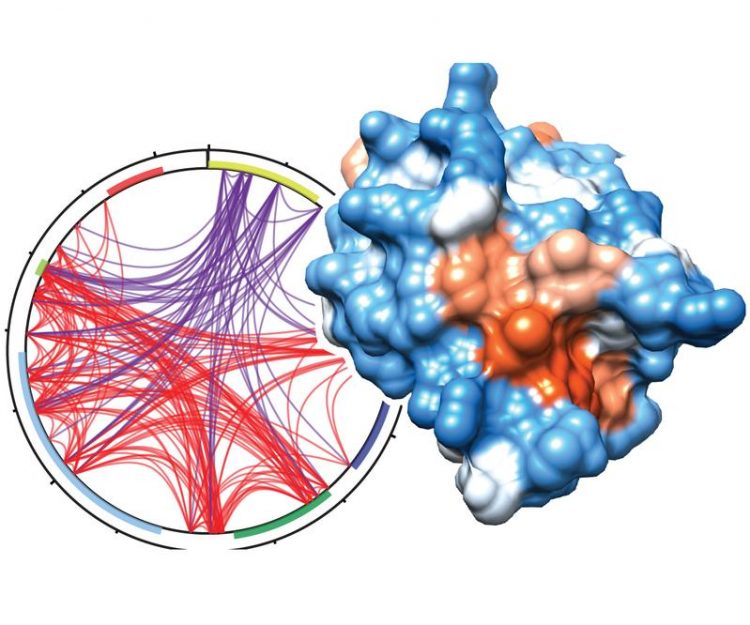A new piece to the puzzle sheds light on how UHRF1 regulates gene activity

UHRF1 may serve as a target for drug therapies. © Helmholtz Zentrum München
All the cells in our body have the same complement of genes yet perform entirely different functions. This is because genes are read differently depending on the type of cell in which they occur.
Gene activity is regulated not only at the level of the DNA sequence but also at the epigenetic level by a variety of chemical modifications made to DNA and histones. “Histones are proteins that ‘package’ the DNA strands in the nucleus into chromosomes. But they also play an important role in controlling gene expression”, says Prof. Dr. Robert Schneider, Director of the Institute of Functional Epigenetics (IFE) at Helmholtz Zentrum München.
Together with other proteins, DNA molecules and histones form chromatin. This constitutes a chemical method for condensing genetic information within the small space of the cell nucleus. Very little is known about these regulatory processes that are the focus of the research at IFE.
UHRF1: a molecule controls key steps in DNA methylation
Researchers know, however, that the protein UHRF1 (Ubiquitin-like, containing PHD and RING finger domains) plays an important role in the methylation of DNA strands. Methyl tags are chemical modifications to a DNA molecule that do not alter the genetic code, i.e. the sequence of bases of the DNA. However, they affect the activity of genes encoded in the base sequence. Methylation of DNA molecules usually acts to repress gene transcription.
UHRF1 controls DNA methylation by ensuring that an enzyme which attaches methyl groups to DNA can bind to newly formed chromatin. To accomplish this task, UHRF1 must first bind to newly formed chromatin itself and, in a second step, transfer an ubiquitin molecule (a small protein that alters the properties of other proteins) to a histone protein. To this end, UHRF1 uses various protein domains, regions with special three-dimensional structures and functions in the same molecule.
“It was not previously known exactly how this works,” says Dr. Till Bartke, Deputy Director of the IFE, who supervised the study. Together with his colleague Dr. Benjamin Foster (post-doctoral researcher at the IFE), he has applied various methods in a bid to shed light on this ubiquitin-transfer step, including chemical crosslinking of molecules, mass spectroscopic studies and the use of recombinant chromatin molecules that were modified with methyl groups.
“We found that an ubiquitin-like domain (UBL) must be present to transfer ubiquitin molecules”, Bartke says. This is a special structural element involved in rearrangements of UHRF1 after it has bound to chromatin. In collaboration with a research group led by Dr. Sebastian Bultmann at Ludwig-Maximilians University Munich, the researchers were also able to show that the UBL domain is required for the methylation of DNA in cells.
“Our analysis of the enzymatic mechanism of UHRF1 reveals an unexpected function of the UBL domain and defines a new role of this domain in DNA methylation,” the scientist explains. Because other groups have found elevated concentrations of UHRF1 in several cancers, including lung and colorectal cancer, the protein, he believes, is well-suited as a target for future therapies.
Further Information
As German Research Center for Environmental Health, Helmholtz Zentrum München pursues the goal of developing personalized medical approaches for the prevention and therapy of major common diseases such as diabetes mellitus and lung diseases. To achieve this, it investigates the interaction of genetics, environmental factors and lifestyle.
The Helmholtz Zentrum München has about 2,300 staff members and is headquartered in Neuherberg in the north of Munich. Helmholtz Zentrum München is a member of the Helmholtz Association, a community of 18 scientific-technical and medical-biological research centers with a total of about 37,000 staff members. http://www.helmholtz-muenchen.de/en
The Institute of Functional Epigenetics is interested in how genes are packaged within the nucleus of a cell. The focus is on the so-called “histone proteins” on which the DNA strands are wound and that can determine whether a gene can be read or not. In addition, we are examining the connections between common diseases and distortions in DNA packing. We utilize cutting edge methods that enable us to follow changes of these processes even in individual cells. http://www.helmholtz-muenchen.de/ife/index.html
Contact for the media:
Department of Communication, Helmholtz Zentrum München – German Research Center for Environmental Health, Ingolstädter Landstr. 1, 85764 Neuherberg – Tel. +49 89 3187 2238 – E-mail: presse@helmholtz-muenchen.de
Dr. Till Bartke, Helmholtz Zentrum München – German Research Center for Environmental Health, Institute of Functional Epigenetics, Ingolstädter Landstr. 1, 85764 Neuherberg – Tel. +49 89 3187 1553, E-mail: till.bartke@helmholtz-muenchen.de
Foster, B. M. et al. (2018): Critical role of the UBL domain in stimulating the E3 ubiquitin ligase activity of UHRF1 toward chromatin. Molecular Cell, DOI: 10.1016/j.molcel.2018.09.028
https://www.cell.com/molecular-cell/fulltext/S1097-2765(18)30799-8
Media Contact
All latest news from the category: Life Sciences and Chemistry
Articles and reports from the Life Sciences and chemistry area deal with applied and basic research into modern biology, chemistry and human medicine.
Valuable information can be found on a range of life sciences fields including bacteriology, biochemistry, bionics, bioinformatics, biophysics, biotechnology, genetics, geobotany, human biology, marine biology, microbiology, molecular biology, cellular biology, zoology, bioinorganic chemistry, microchemistry and environmental chemistry.
Newest articles

Future AR/VR controllers could be the palm of your hand
Carnegie Mellon University’s EgoTouch creates simple interfaces for virtual and augmented reality. The new generation of augmented and virtual reality controllers may not just fit in the palm of your…

‘Game changer’ in lithium extraction
Rice researchers develop novel electrochemical reactor. A team of Rice University researchers led by Lisa Biswal and Haotian Wang has developed an innovative electrochemical reactor to extract lithium from natural…

The blue-green sustainable proteins of seaweed
… may soon be on your plate. The protein in sea lettuce, a type of seaweed, is a promising complement to both meat and other current alternative protein sources. Seaweed…



